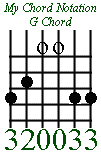
Chord Notation
If you've been looking at these lessons and are confused about the 320033 notation style I use to express chords, then this is the page for you. This system is one of the latest systems of expressing chords used by guitarists on the net, so it is a good idea to understand it. Here goes nothing.
First, the six numbers in my notation refers to the six strings on your guitar, low strings appearing on the left. Basically this is how your strings would appear if you held your guitar neck vertically and looked at it. The numbers refer to the fret on each string that you press to make the chord. So a G chord is notated and played as follows:

The numbers have nothing to do with which fingers you use to play each string.
An "O" means that string should be played open.
An "X" means that that string should not be played (as in D: xx0232) or that it should be muted (as in E/G#: 4x2400). This is discussed below.
In D (xx0232) it is simple to avoid playing the fifth and sixth strings, but it is impossible to "dodge" the fifth string in the E/G# (4x2400). Therefore, one of your fingers is often placed against the fifth string while forming the E/G# chord, therefore preventing the vibration of the fifth string. This is called muting and is a common practice. Any finger and any string can be used in muting. I even use muting when I play an A chord (x02220): I wrap my thumb around the fretboard and mute the sixth string to ensure that I don't play it. When approaching any chord that has a muted string marked, it should be easy to figure out which finger should mute the string; you must concentrate on actually muting the string. This should come easily with practice.
This should clear up any confusion on my chord notation. If there are any further questions, please e-mail me. Good luck and have fun.
For my archive of common chords, click here.
Back to Dansm's Guitar Chord Theory
You are visitor number
© 1997 Daniel E. Smith.